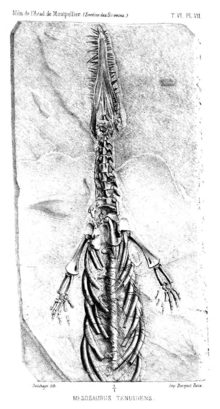Mesosaurus
| Mesosaurus Temporal range:
| |
|---|---|

| |
| Holotype of Mesosaurus tenuidens (specimen MNHN 1865-77) | |
| Scientific classification | |
| Domain: | Eukaryota |
| Kingdom: | Animalia |
| Phylum: | Chordata |
| Class: | Reptilia |
| Clade: | †Parareptilia |
| Order: | †Mesosauria |
| Family: | †Mesosauridae |
| Genus: | †Mesosaurus Gervais, 1865[1] |
| Species: | †M. tenuidens
|
| Binomial name | |
| †Mesosaurus tenuidens Gervais, 1865[1]
| |
| Synonyms | |
Mesosaurus (meaning "middle lizard") is an
Discovery and naming
The
Since then, Mesosaurus remains have also been identified from South America and were first identified in 1908 as belonging to a second species, M. brasiliensis, by J. H. MacGregor.[9] Later studies have shown that M. brasiliensis was the same animal as M. tenuidens, which remains as the single valid species of Mesosaurus to this day.
Two other species of mesosaurids have since been described, which are Stereosternum[10] and Brazilosaurus,[11] which are also considered to be synonyms of Mesosaurus tenuidens according to Piñeiro et al. (2021).[2]
Description
Mesosaurus had a long skull that was larger than that of Stereosternum and had longer teeth. The teeth are angled outwards, especially those at the tips of the jaws.[12]
The bones of the postcranial skeleton are thick, having undergone
Palaeobiology
Mesosaurus was one of the first reptiles known to have returned to the water after early
Mesosaurus had a small
The pachyostosis seen in the bones of Mesosaurus may have enabled it to reach neutral buoyancy in the upper few meters of the water column. The additional weight may have stabilized the animal at the water's surface. Alternatively, it could have given Mesosaurus greater momentum when gliding underwater. While many features suggest a wholly aquatic lifestyle,[16] Mesosaurus may have been able to move onto land for short periods of time. Its elbows and ankles were restricted in their movement, making walking appear impossible. It is more likely that if Mesosaurus moved onto land, it would push itself forward in a similar way to living female sea turtles when nesting on beaches.[13]
Clearly
A study on vertebral column proportions suggested that, while young Mesosaurus might have been fully aquatic, adult animals spent some time on land. This is supported by the rarity of adult animals in aquatic settings, and a coprolite possessing drying fractures. However, how terrestrial these animals were is difficult to say, as their pachyostosis and other adaptations for an aquatic lifestyle would have made foraging on land difficult.[18]
Distribution
Mesosaurus was significant in providing evidence for the theory of continental drift, because its remains were found in southern Africa, Whitehill Formation, and eastern South America (Melo Formation, Uruguay and Irati Formation, Brazil), two widely separated regions.[19][20] As Mesosaurus was a coastal animal, and therefore less likely to have crossed the Atlantic Ocean, this distribution indicated that the two continents used to be joined together.
Gallery
-
Fossil from Brazil
-
Fossil from Brazil
-
Dual fossil in Louisiana
-
Restoration
-
Early reconstruction of the skeleton of M. brasiliensis showing many small teeth in the jaws (MacGregor, 1908).[9]
-
Fossil of unhatched juvenile or fetus of Mesosaurus tenuidens (FC-DPV 2504) from Uruguay
-
Skeleton molds in whitish weathering shales of the Whitehill Formation, Keetmanshoop, Namibia
-
Distribution of four Permian and Triassic fossil groups used as biogeographic evidence for continental drift, and land bridging. Location of Mesosaurus remains shown by green squares
References
- ^ a b c d Gervais, P. (1865). Description du Mesosaurus tenuidens. Reptile fossile de l'Afrique australe. Académie des Sciences et Lettres de Montpellier. Mémoires de la Section des Sciences 6(2):169-175
- ^ S2CID 244188443.
- .
- ^ Huene, F. von (1940). "Osteologie und systematische Stellung von Mesosaurus". Palaeontographica Abteilung A. 92: 45–58.
- .
- ^ Piñeiro, Graciela (2008). "Los mesosaurios y otros fosiles de fines del Paleozoico". In D. Perera (ed.). Fósiles de Uruguay. DIRAC, Montevideo.
- .
- ^ Helm, Charles & Benoit, Julien. (2019). Geomythology in Southern Africa. ResearchGate 36.
- ^ a b MacGregor, J.H. (1908) Mesosaurus brasiliensis nov. sp. IN: White, I.C. (1908) Commission for Studies on Brazilian Coal Mines - Final Report; (Bilingual report, Portuguese & English), Imprensa Nacional, Rio de Janeiro, Brazil, 617 p.: Part II, pp. 301-336.
- ^ Cope, E.D. (1885). A contribution to the vertebrate paleontology of Brazil. Proceedings of the American Philosophical Society 25, 7-15.
- ^ T. Shikama and H. Ozaki (1966). "On a Reptilian Skeleton from the Palaeozoic Formation of San Paulo, Brazil". Transactions and Proceedings of the Palaeontological Society of Japan. New Series. 64: 351–358.
- ^ .
- ^ S2CID 131561248.
- ISBN 978-0-520-26647-6.
- ^ ISBN 978-1-84028-152-1.
- .
- S2CID 59475679.
- ^ Piñeiro, Graciela (2008). D. Perera (ed.). Fósiles de Uruguay. DIRAC, Montevideoy.
- ISBN 9781118786352.
Further reading
- Parker, Steve. Dinosaurus: the complete guide to dinosaurs. Firefly Books Inc, 2003. Pg. 90
- Carroll, R. L. (1988). Vertebrate Paleontology and Evolution. W.H. Freeman and Company. ISBN 9780716718222.
- LeGrand, Homer Eugene (1988). Drifting Continents and Shifting Theories: The Modern Revolution in Geology and Scientific Change (illustrated ed.). Cambridge University Press. pp. 313. ISBN 978-0-521-31105-2.
- ISBN 978-0-262-63197-6.
- Sepkoski, Jack (2002). "A compendium of fossil marine animal genera". Bulletins of American Paleontology. 363: 5–560. ISBN 978-0-87710-450-6.







